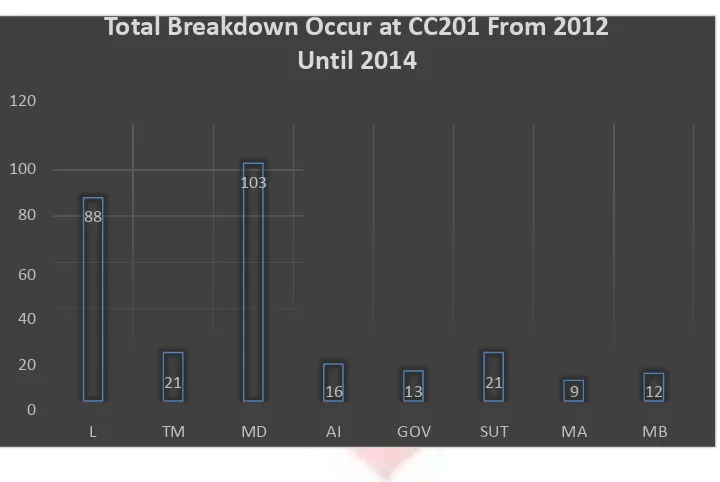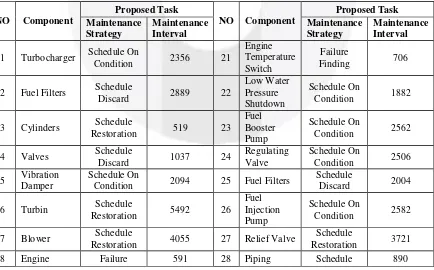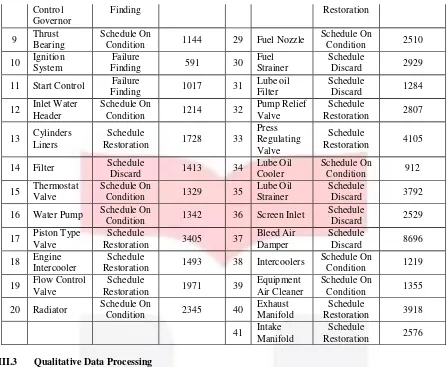MAINTENANCE TASK DEVELOPMENT FOR LOCOMOTIVE TYPES CC201
USING RELIABILITY-CENTERED MAINTENANCE II (RCM II) METHOD AT PT
KAI DIPO LOCOMOTIVE OPERATIONAL AREA II BANDUNG
1Deya Ika Wardani, 2Sutrisno, 3Rohmat Saedudin123Industrial Engineering Industrial Engineering Faculty Telkom University
Email : [email protected], [email protected], roja [email protected]
ABSTRACT
PT Kereta Api Indonesia (PT KAI) is a Government-owned corporation that provide train as mass public transportation. PT KAI DIPO Locomotive Operational Area II Bandung (PT KAI DL DAOP II BD) is a plant that operates in Bandung. Locomotive is one of the facilities that is owned by a train. PT KAI implementing preventive and corrective maintenance, with maintenance period for a month, 3 months, 6 months, 12 months, semi-overhaul for every 1 year and overhaul for every 2 years. They also did daily check and monthly check to assess the machine condition. The locomotive system is divided into several system, such as electrical control system, diesel engine, pneumatic system, mechanical system and so on. If serious failures occurs on Locomotive, then it caused the whole train to stop working altogeter. Therefore, improvement on maintenance task for locomotive in PT KAI DL DAOP II BD is needed, as well as determining the optimal maintenance interval while considering maintenance cost, and risk of failure.
The method used in this research is a Reliability Centered Maintenance to find the optimal maintenance strategy and maintenance tasks. This research also using RCM++ software to calculate the optimal maintenance interval for component in Diesel Engine.
First step in research is to conduct a quantitative calculation to determine the Mean Time To Repair and Mean Time To Failure for component in Diesel Engine. Next is conduct qualitative data processing using RCM II. The results are known maintenance strategy and maintenance task for engine components. There are four choosen strategy, they are Schedule On-Condition, Schedule Restoration, Schedule Discard and Failure Finding. After learning care policies for each component, then determined the maintenance intervals and maintenance costs for each component using RCM++ software.
Keyword : RCM II, locomotives, RCM++
I INTRODUCTION
PT Kereta Api Indonesia (PT KAI) is a Government-owned corporation that provide train as mass public transportation. There are 2 services ministered by PT KAI, passenger train and goods train. Locomotive is one of the facilities that is owned by a train. It is a part of the train where machine located and its jobs is to move the whole train. If serious failures occurs on Locomotive, then it caused the whole train to stop working altogeter. PT KAI DIPO Locomotive Operational Area II Bandung (PT KAI DL DAOP II BD) is a plant that operates in Bandung. PT KAI DL DAOP II BD own some type of diesel electric locomotive, they are CC201, CC203, and CC206. PT KAI implementing preventive and corrective maintenance, with maintenance period for a month, 3 months, 6 months, 12 months, semi-overhaul for every 1 year and overhaul for every 2 years. They also did daily check and monthly check to assess the machine condition. The locomotive system is divided into several system, such as electrical control system, diesel engine, pneumatic system, mechanical system and so on. PT KAI DL DAOP II BD has classified the types of failure for locomotive, they are :
Table I. 1 Type of Failure
Type of Failure Code
Electrical control system L
Traction motor TM
Diesel Engine MD
Pneumatic system SUT
Upper mechanical MA
Input air system + Turbo AI
Lower mechanical MB
120
Total Breakdown Occur at CC201 From 2012
Until 2014
100
80 88
103
60
40
20
21
16 13 21 9 12 0
L TM MD AI GOV SUT MA MB
Figure I.1 Total Breakdown Occur at CC201 From 2012 Until 2014
Figure shown above shows the frequency of failure for January 2012 to December 2014. It appears that Diesel engine has the highest failure frequency. Noted the competence that must be achieved by the company are to fulfill customers demand,while the safety aspectalso considered. If company rely their machine on corrective maintenance, it will affect the train performances and total cost spent. Unpredictable breakdown occurs will disrupt the train schedule, whereas the locomotive available are limited. Furthermore, if breakdown occurs in the middle of a train trip, it can cause a significant effect, for example train accident that can harm passenger’s life. Therefore, improvement on maintenance activity for locomotive in PT KAI DL DAOP II BD is needed, as well as determining the optimal maintenance interval while considering maintenance cost, and risk of failure using Reliability-Centered Maintenance II (RCM II).
II RESEARCH METHODOLOGY
2.1 Maintenance Strategy
Maintenance is an activity to ensuring that physical assets continue to do what their users want them to do (Moubray, 1991). Meanwhile Ebeling describe maintenance as an activity so the sub system or the broken system will be repaired in the mean condition and in the mean period.(Ebeling, 1997). In general, there are four basic maintenance strategies to address a potential failure mechanism:
2.2.1 Preventive Maintenance
Time based maintenance is a form of maintenance of an asset according to a strict timetable schedule. Time based maintenance consist of three maintenance strategy, they are :
1. Schedule Inspection 2. Schedule Restoration 3. Schedule Replacement
RCM recognize two types of life-limits related to schedule discard/restoration. They are safe-life limits and economic life limits. The maintenance interval for the equipment with safety consequences are range from 0.3 - 0.5 of MTTF. For the economy life limit, the maintenance interval are range from 0.8-0.9 of MTTF. The formulation to calculate the task interval are:
Safe life limit = 0.3 x MTTF Economic life limit = 0.9 x MTTF
∞ 1
Condition Based Maintenance (CBM) is a maintenance strategy based on the actual condition of the assets to decide what maintenance to be done. This strategy dictates that maintenance performed when assets shows indicators of potential failure. The determination of maintenance interval for condition based maintenance are based on the P-F interval and the lead time of the component. he maintenance interval shol be less than the P-F Interval and lead time of the component. The task interval should be higher than the lead time, to give opportunity for the company to order the needed component. So, it can either 1⁄2 𝑃 −𝐹 ����𝑡���𝑣����, 1⁄3 𝑃 − 𝐹 ����𝑡���𝑣����, 1⁄4 𝑃 −𝐹 ����𝑡���𝑣����, or so on, based on the company condition. The basic formula to calculate condition based task are:
2.2.1.2 Failure Finding
Maintenance Interval (hour) = 1 x PF Interval
2
If there are no preventive maintenance are suitable to be applied to the assets, then one of the option can be choosen to be applied are failure finding. Moubray define failure finding as task design to check wether something still work. The task iteslf are by simply checking if the equipment still works.
There are some condition to get the failure finding interval, they are: a) MTIVE = Mean time to failure of the component
b) The unavailability of the component.
c) The calculation of failure finding interval based on the equation Te formula to calculate maintenance interval for failure finding are:
Failure Finding Interval (FFI) = 2 x Unavailability x MTIVE 2.2.1.3 Run To Failure
In this strategy, assets are deliberately allowed to operate until they breakdown, at which point reactive maintenance is performed.
2.2.2 Breakdown
Breakdown maintenance is maintenance performmed on equipment that has broken down. It is based on a breakdown maintenance trigger. Breakdown maintenance may be either planned or it can be planned. Breakdown maintenance can be more costly than preventive maintenance.
2.2 Mean Time To Failure and Mean Time To Repair
Mean Time To Failure (MTTF) is the average time or failure expectation of a component or system work in normal condition. MTTF often referred as usage estimation of a component. Mean time to repair is the average time for a component to be repaired. The formula to calculate MTTR and MTTF are :
1. Normal Distribution
The parameter for Normal Distribution are mean (�) and standard deviation (��). The cumulative distribution for Normal Distribution is given by :
��(��) = Φ (𝑡 −� ) ... (II.12) 𝜎
And the reliability function is given by :
��(��) = Φ (𝑡 −𝜎� ) ... (II.13)
Where the MTTF is equal to mean (�).
2. Weibull Distribution
If only two parameters is used, 𝜂 and ��, then it called Weibull distribution with 2 parameters (2-Parameter Weibull). The cumulative distribution for Exponential Distribution is given by :
Where the average failure time with 2-P Weibull is given by :
MTTF=��. Γ (1 + 1 ) ... (II.17) 𝛽
3. Exponential Distribution
The parameter for Exponential Distribution is lambda (�) , which is constant with time (T). ). The cumulative distribution for Exponential Distribution is given by :
��(��) = 1 −�−��� ... (II.14)
Where the average failure time is given by :
MTF=∫ ��(��)�𝑡 = ... (II.15) 𝑇 �
2.3 Reliability Centered Maintenance PP (RCM II)
Reliability-centered Maintenance is a process used to determine the maintenance requirements of any physical asset in its operating context(Moubray, 1991). Moubray state that the RCM process entails asking seven question about the asset or system under review.
The failure mode is a condition that can cause functional damage. In a machine, there can be dozens of failure modes. The failure modes include not only the failure that has occurred, but also cover all failure that may occur. If the failure has been known to fashion it is possible to determine the impact of the failure that describes what will happen when the failure modes occur, to further used to determine the consequences and decide what will be done to anticipate, prevent, detect or repair. FMEA itself is the answer 4 questions beginning at 7 basic questions to start analyzing RCM.
2.2.2 The RCM Information Sheet
RCM information sheet is a document containing of the detailed information about function and standard procedure, functional failure, failure model, and the failure effects.
2.2.3 The RCM Decision Sheet
The RCM Decision sheet is to make the last decision about the maintenance activity for every failure. The RCM decision sheet can be seen as in figure II.8. The flow of filling the RCM decision sheet is purposing in the RCM diagram decision
2.4 Maintenance Cost
The calculation of maintenance cost differ from one maintenance strategy to other. The calculation for every maintenance strategy are :
1. Preventive maintenance :
a. Schedule Replacement = Material Cost + Engineer Cost + Component Cost + Downtime Cost b. Schedule Restoration = Material Cost + Engineer Cost + Repair Cost + Downtime cost c. Schedule Inspection = Tools Cost + Engineer Cost
2. Corrective Maintenance :
a. Direct Cost = Material Cost + Engineer Cost + Component Cost
b. Undirect Cost = Downtime Cost
III DATA ANALYSIS
III.1 Build Equipment Hierarchy
The object of this research is Diesel Engine from Locomotives CC201/CC203/CC206 at PT KAI DIPO Locomotibes Operational Area II Bandung.. Diesel engine located on the level 6 at System Breakdown Structure. For this research, the system are brean until level 8 or maintainable item. The result is there are 41 maintainable item for diesel engine.
III.2 Quantitative Calculation
In this step, there will be calculation for the Mean time to failure and Mean time to repair for every component. Table III. 1 Maintenance Interval
1 Turbocharger Schedule On
Condition 2356 21
3 Cylinders Schedule
Restoration 519 23
Restoration 4055 27 Relief Valve
Schedule
Restoration 3721
Control Governor
Finding Restoration
9 Thrust
11 Start Control Failure
Finding 1017 31
Restoration 1493 38 Intercoolers
Schedule On
20 Radiator Schedule On Condition 2345 40 Exhaust Manifold Restoration Schedule 3918
41 Intake machine. The resume og the information and decision sheet can be seen on table III.
Table III. 2 Maintenance Task for Diesel Engine
No Maintenance
Strategy Equipment Failure Mode Maintenance Task
1 Schedule On
Condition Turbocharger Low Output check the seal, vibration, noise
2 Schedule On
Condition Turbocharger High Output check the seal, vibration, noise
3 Schedule On
check for vibration, noise, loose seal
jammed check for vibration
5 Schedule On
check the sensor, tighten the seal
water tank check the sensor
8 Schedule On
Condition Radiator
Radiator hosing
split check the hosing split
9 Schedule On
shut down check the sensor
Condition Pump body pump
pressure check the fuel pressure
12 Schedule On
Condition
Fuel Injection
Pump The pump is broke
check the pump for any vibration, noise
13 Schedule On
Condition Fuel Nozzle
The nozzle tip is
hollow check for any hollow)
14 Schedule On
Condition
Lube Oil
Cooler Leakage check the cooler for leakage
15 Schedule On
Condition Intercoolers
Clogged in the
passage check for clogged
16 Schedule On
Condition
Equipment Air
Cleaner Clogged check for clogged
17 Schedule On
Condition Water Pump
Damage on the
pump body repair the pump body
18 Schedule
Discard Fuel Filters
The filter is loaded
of dirt change the filter
19 Schedule
Discard Valves
Valve body is
broken change the valves
20 Schedule
Discard Filter
The filter is loaded
of dirt change the filter
21 Schedule
Discard Filter
The filter is not
working change the filter
22 Schedule
Discard Fuel Filter
The filter is loaded
of dirt change the filter
23 Schedule Discard Fuel Filter The filter is not working change the filter
24 Schedule
Discard Fuel Strainer
The strainer is
clogged change the strainer
25 Schedule
Discard
Lube Oil Filter
There are foreign
material on the oil change the filter
26 Schedule
Discard
Lube Oil
Strainer Leakage change the strainer
27 Schedule
Discard Screen Inlet
The screen inlet is
perforated change the screen inlet
28 Schedule
change the bleed air damper
29 Schedule
Restoration Turbocharger
No air suspension
appear restore the fan
30 Schedule
Restoration Cylinders Leakage weld the cylinder case
31 Schedule
Liners Leakage weld the cylinders liners
34 Schedule
check the sensor, change the valve
35 Schedule
Restoration
Engine
Intercooler Leakage
weld the intercooler, tighten the seal
working change the valve
37 Schedule
check the pump for any vibration, noise
Restoration damage
39 Schedule
Restoration Piping
The pipe is damage
change/weld the pipe, clean the pipe
damage repair/weld the case
43 Schedule
Restoration
Intake Manifold
The pipe is
damage change the pipe
44 Failure
rheostat change the circuit
45 Failure
Finding
Ignition
System Spark plug defect change the wire or the coil
46 Failure
Finding Start Control The switch is loose
change the circuit, tighten the seal
IV CONCLUSION AND SUGGESTION IV.1 Conclusion
The conclusion of this research are:
1. The system breakdown system from level 6 until level 8 for Diesel Engine show that diesel engine has 41 maintainable item.
2. There are 4 maintenance strategy assign for diesel engine, they are schedule on condition, schedule restoration, schedule discard, and failure finding. From 41 maintainable item on diesel engine, there are 48 maintenance strategy assigned. Based on the analysis using RCM method, the proposed maintenance strategy are consist of 17 schedule on-condition, 11 schedule discard, 15 schedule restoration and 5 failure
finding.
3. The maintenance task for every component is different from one to another, based on their failure mode and their maintenance strategy.
4. The maintenance interval for every component are determined based on their maintenance strategy. IV.2 Suggestion
VI.2.1 Suggestion for Company
1. PT KAI should make a better record system to make structured historical data for future usage. They should make a detail and systematically historical data so that every failure occur can be identify.
2. PT KAI should assign maintenance strategy and task based on the characteristic of the component.
3. PT KAI need to do evaluation to the existing maintenance activity, to know the effectiveness of the existing maintenance.
VI.2.2 Suggestion for Next Research
1. This research doesn’t consider about the need for spare part for diesel engine. The next research preferably consider the need for spare part.
BIBLIOGRAPGHY
ANSI. 2004. ISO 14224:2004. Petroleum and natural gas industries - Collection and exchange of reliability and maintenance data for equipment.
Ebeling, C. E. 1997. An Introduction to Reliability and Maintainability Engineering. Singapore: McGraw-Hill.
Ir. Sutrisno, M. 2011. Handout Kuliah Manajemen Perawatan. Bandung: IT Telkom.
Moubray, J. 1991. Reliability Centered Maintenance . Oxford: Buttenworth-Heinemann Ltd.


